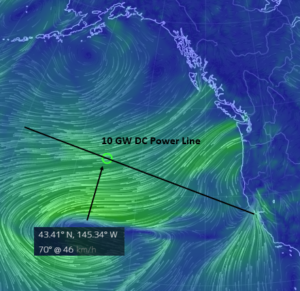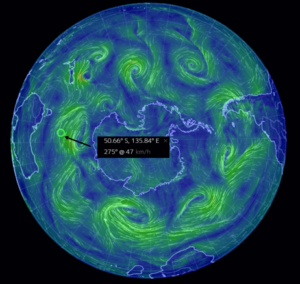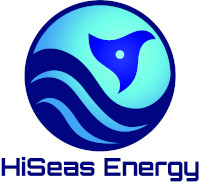Offshore California
California has pledged to achieve 100% fossil-free electric power generation by 2045, but this requires about 20 GW of low cost renewable power delivered at a high capacity factor. Solar with batteries is not likely to achieve this due to the high cost and limited lifetime of batteries for daily cycling. The capacity for land-based wind turbines in or near California has largely been tapped, and conventional offshore shallow water (< 1000 meter) turbine installations are highly restricted by both the military and the public, and in any case cannot be low cost.
HiSeas turbines may be placed far offshore in deep water not accessible by any other technology and not subject to military or public constraints. Ocean bottom high voltage AC or DC power cables may bring the power directly to markets such as the Bay Area. There is no “not in my backyard” problem with the HiSeas turbines or the transmission lines.
Further, HiSeas turbines may be strung along high voltage, ocean bottom DC cables for up to 1 or even 2 thousand miles across the vast north-east Pacific, much like fiber optic cables laid out on the ocean floor. Since these long DC lines will be accessing more than one weather system simultaneously, generating net capacity factors over 90%, storage needed to achieve 100% renewable power will be minimal.

To be truly free of fossil fuels, California will also need to replace its huge consumption of natural gas for winter-time heating and oil for transportation, with the HiSeas turbine being the only low-cost candidate capable of the required scale, capacity factor, and winter-time availability.
Cost projections using available turbines and the HiSeas platform, base on the ARPA-E ATLANTIS costing spreadsheet, and wind data from earth.nullschool.net, predict initial costs at $37/MW-hr, with costs declining from that as volume increases. This is about half of the ARPA-E ATLANTIS goal of $75 MW-hr and is more than competitive with electric power from natural gas.
Southern Ocean
Solving the greenhouse gas problem which is causing global warming will take much more than achieving 100% renewable electric power in select markets. The world’s economy must be weaned from fossil fuels for electric power production, transportation, heating, and industrial processes including steel, aluminum, and concrete production. This can only be done with a hydrogen economy where the hydrogen is generated at very low cost at huge scale and distributed in a convenient form, such as hydrogen enriched oil or liquid hydrogen.
The HiSeas Turbine/Platform is capable of both the required scale and cost, when operated in the Southern Ocean. This vast sea area between the 40th and 60th south latitudes, comprising 40 million square kilometers (8% of the earth’s surface) of wind-swept ocean, surrounds Antarctica and circles the earth. It is also by far the windiest place on earth, as the tropics, the vast ice sheets of Antarctica, and the atmosphere form a global scale heat engine of almost unimaginable power.
Simple calculations of the world’s energy usage in all forms, and wind data from the Southern Ocean from earth.nullschool.net, and assuming a 50% total efficiency from turbine power to end use power or fuels, indicate that about 500,000, 40 MW HiSeas turbines, tapping less than 10% of the available wind power of the Southern Ocean, can displace all fossil fuels at a price comparable to or lower than fossil fuels. At $1,000/kW, this suggests a total value of $20 trillion for the turbines, platforms, and fuel processors, to supply the same energy as is currently being supplied by fossil fuels, worldwide.

